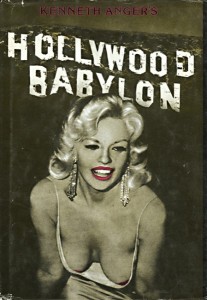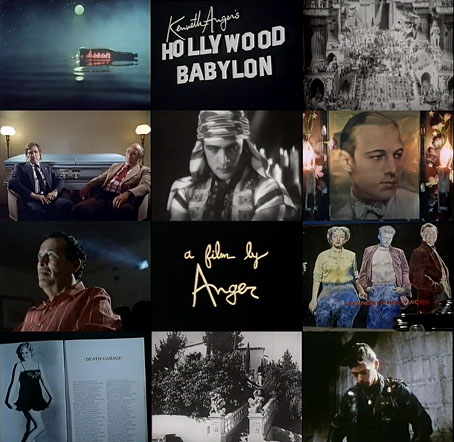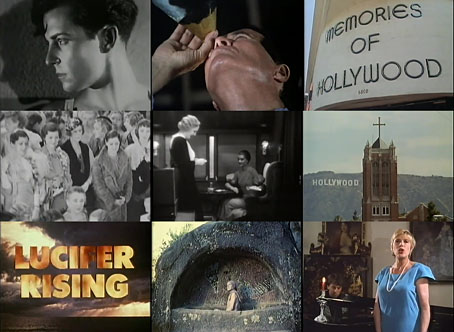
Dokumentarac (koji Anger nije volio) o Angeru i njegovoj skandaloznoj knjizi Hollywood Babylon.
Hollywood Babylon is a book by avant-garde filmmaker Kenneth Anger which details the sordid scandals of many famous and infamous Hollywood denizens from the 1900s to the 1950s. First published in the US in 1965, it was banned ten days later and would not be republished until 1975. Upon its second release, the New York Times said of it, "If a book such as this can be said to have charm, it lies in the fact that here is a book without one single redeeming merit. - wikipedia
Nigel Finch was a key member of the team of producers and directors working on the BBC’s Arena arts documentaries throughout their golden run during the 1980s and 1990s. The films he directed himself—among them studies of Robert Mapplethorpe’s photography, and a history of the Chelsea Hotel in New York—gave him an opportunity to push some gay content into the TV schedules at a time when Britain’s gay population were seen as enough of a public threat to be legislated against. Some of that proselytising impulse can be found in Kenneth Anger’s Hollywood Babylon (1991), an hour-long documentary which alternates the life and work of the filmmaker with readings and enactments of the lurid episodes recounted in Anger’s scandal anthologies, Hollywood Babylon andHollywood Babylon II. Finch at one point asks whether Fireworks, the first film in Anger’s Magick Lantern Cycle, should be regarded as a pioneering piece of gay cinema; Anger’s says he’s happy if people take it that way but says little else about its evident homoerotic atmosphere. He remains as resistant to identity politics as he’s always been. (See theunauthorised biography by Bill Landis for details.)
Between the readings and interview sections Finch shows Anger being chauffeured around Beverly Hills in a hearse which stops occasionally at some locus of bygone scandal. Most of the Anger anecdotes are familiar ones from subsequent interviews but there is a bonus for Angerphiles with the appearance at the end of Marianne Faithfull who talks a little about their relationship before singing Boulevard Of Broken Dreams. The picture quality of this YouTube copy could be better but it’s watchable enough. - www.johncoulthart.com/

Kenneth Anger didn’t like Nigel Finch’s documentary on Hollywood Babylon. He thought Finch’s film ended up more about Finch than it did about Anger. It was like a test run for making a movie, which of course Finch went on to make. Anger told me this while we waited in my room, at the Standard Hotel, West Hollywood, Fall 2004. I was about to interview Kenneth for a documentary, and while we chatted, waiting for the crew to set-up, he tore stories out of tabloid newspapers to send to the Kinsey Institute, and I smoked on the balcony, watching the shimmer of eucalyptus trees in the late morning breeze.
When it was time for the interview, we walked along the orange-carpeted corridor only to be stopped by another film crew who were making a movie. At a half-corridor stood George Clooney and Brad Pitt, filming a scene for Ocean’s Twelve. Both looked smaller, their heads somehow bigger. They must have kept their magic for the camera, for it seemed that neither had the presence or, looked as grand a star as Kenneth Anger, who stood half in shadow, quietly waiting by the AD.
Nigel Finch’s ambitious documentary uses Kenneth Anger’s Hollywood Babylon as its keystone to build a film about Anger’s life, his movies, his interest in Hollywood and its stars’ scandalous lives. But what is evident amongst all this is that Anger is too big a genius, too complex a character to be fitted in between dramatic reconstructions of Fatty Arbuckle, and tales of Hollywood death and disaster. Though there are some excellent moments, the documentary teases the viewer, leaving an unfulfilled desire to know more about the great Magus of Cinema. Still, it’s worth the price of admission, if only to catch Kenneth Anger on film. - Paul Gallagher

Kenneth Anger didn’t like Nigel Finch’s documentary on Hollywood Babylon. He thought Finch’s film ended up more about Finch than it did about Anger. It was like a test run for making a movie, which of course Finch went on to make. Anger told me this while we waited in my room, at the Standard Hotel, West Hollywood, Fall 2004. I was about to interview Kenneth for a documentary, and while we chatted, waiting for the crew to set-up, he tore stories out of tabloid newspapers to send to the Kinsey Institute, and I smoked on the balcony, watching the shimmer of eucalyptus trees in the late morning breeze.
Missoni by Kenneth Anger
I did have another Ludwig post planned for today but that’s been set aside for a different kind of fabulosity following the news that Kenneth Anger has made a new film. Yes, jaws hit the floor… Italian fashion house Missoni commissioned Anger to make a short promo for their Fall/Winter collection and you can see the delirious results in high-resolution here. The film features Missoni family members peering out from among the layered moons and stars while the titles are by Arthur magazine’s Psychedelic Healing Visions Correspondent, Alia Penner.
“I’m fascinated by Kenneth Anger’s use of color and his ability to transform a film into a three-dimensional texture, a fabric of images in movement,” explained Angela Missoni. This is how she introduced her decision to entrust the Missoni F/W 2011 campaign to one of America’s most famous authors and directors of avant-garde cinema.Anger—a hyperactive octogenarian who loves working in the wee hours of the night and at dawn using sophisticated instruments such as the RED digital camera that has the characteristics of a classic 35 mm camera—flew in from Los Angeles to film the campaign in Sumirago that involved all the members of the great Missoni family. They are the stars of this campaign that was conceived as a series of superimposed and overlapping portraits
"I'm fascinated by Kenneth Anger's use of color and his ability to transform a film into a three-dimensional texture, a fabric of images in movement," explained Angela Missoni. This is how she introduced her decision to entrust the Missoni F/W 2011 campaign to one of America's most famous authors and directors of avant-garde cinema.
Anger -- a hyperactive octogenarian who loves working in the wee hours of the night and at dawn using sophisticated instruments such as the RED digital camera that has the characteristics of a classic 35 mm camera - flew in from Los Angeles to film the campaign in Sumirago that involved all the members of the great Missoni family. They are the stars of this campaign that was conceived as a series of superimposed and overlapping portraits. Vogue.it presents a preview of this film: a vibrant and impalpable evocation of unique patterns, patchwork motifs, stitches, knits, and styles, it is a symbolic weave as ephemeral as a dream.
"The images of Juergen Teller for the S/S 2010 campaign reflected and portrayed our everyday family life," said Angela. "Kenneth Anger's experimental approach and his narrative style, on the other hand, transformed the new campaign into a sublimation of our world." The style of this ad campaign that verges on art clearly reveals the taste of this Californian filmmaker, who directed the films "Fireworks", "Puce Moment" and "Scorpio Rising", wrote successful books such as "Hollywood Babylon" dedicated to the secrets, manias, perversions and scandals of early Hollywood film stars, and is a favorite of young fans. Included in the 2006 edition of the Whitney Biennial of New York, he currently works with some of the most important international galleries of contemporary art and enjoys much popularity today.
A man of few words, this fascinating former actor who still takes care of his appearance first filmed the settings for his film"Missoni": mostly locations near bodies of water in the Sumirago countryside and part of Rosita and Ottavio's garden. For the indoor sequences, he built a set in the Council Room of the Sumirago Town Hall, a basement room with a vaulted ceiling. The mood of the film and the poses and movements of Margherita, Jennifer, Angela, Rosita, Ottavio, Ottavio Jr. and all other family members are reminiscent ofSergei Parajanov's "The Color of Pomegranates", a 1968 film that inspired Anger to create his Chinese box-style storyboard.
The intertwining and blending of moods, micro-plots, and situations make his "Missoni" a dream of a film within a film, a surreal dreamy interaction of spaces, faces, gestures, clothes, and costumes with different ages and narrative tempos. "Before he left," said Angela, "he gave my mother, with whom he became fast friends, a film award he recently received." To the question, "What did he leave you?" she answered with her usual humor, "Twenty-five wigs!" In Anger's film, the wigs appear in a minimum part and are worn by Margherita, the protagonist with Jennifer of a project that will enchant, document, but not illustrate fashion.
The film expresses Missoni's sophisticated choice and desire to amplify the role of images, making them a communication means and not an end, instruments for personal forms of appropriation and interpretation. Mariuccia Casadio
Anger -- a hyperactive octogenarian who loves working in the wee hours of the night and at dawn using sophisticated instruments such as the RED digital camera that has the characteristics of a classic 35 mm camera - flew in from Los Angeles to film the campaign in Sumirago that involved all the members of the great Missoni family. They are the stars of this campaign that was conceived as a series of superimposed and overlapping portraits. Vogue.it presents a preview of this film: a vibrant and impalpable evocation of unique patterns, patchwork motifs, stitches, knits, and styles, it is a symbolic weave as ephemeral as a dream.
"The images of Juergen Teller for the S/S 2010 campaign reflected and portrayed our everyday family life," said Angela. "Kenneth Anger's experimental approach and his narrative style, on the other hand, transformed the new campaign into a sublimation of our world." The style of this ad campaign that verges on art clearly reveals the taste of this Californian filmmaker, who directed the films "Fireworks", "Puce Moment" and "Scorpio Rising", wrote successful books such as "Hollywood Babylon" dedicated to the secrets, manias, perversions and scandals of early Hollywood film stars, and is a favorite of young fans. Included in the 2006 edition of the Whitney Biennial of New York, he currently works with some of the most important international galleries of contemporary art and enjoys much popularity today.
A man of few words, this fascinating former actor who still takes care of his appearance first filmed the settings for his film"Missoni": mostly locations near bodies of water in the Sumirago countryside and part of Rosita and Ottavio's garden. For the indoor sequences, he built a set in the Council Room of the Sumirago Town Hall, a basement room with a vaulted ceiling. The mood of the film and the poses and movements of Margherita, Jennifer, Angela, Rosita, Ottavio, Ottavio Jr. and all other family members are reminiscent ofSergei Parajanov's "The Color of Pomegranates", a 1968 film that inspired Anger to create his Chinese box-style storyboard.
The intertwining and blending of moods, micro-plots, and situations make his "Missoni" a dream of a film within a film, a surreal dreamy interaction of spaces, faces, gestures, clothes, and costumes with different ages and narrative tempos. "Before he left," said Angela, "he gave my mother, with whom he became fast friends, a film award he recently received." To the question, "What did he leave you?" she answered with her usual humor, "Twenty-five wigs!" In Anger's film, the wigs appear in a minimum part and are worn by Margherita, the protagonist with Jennifer of a project that will enchant, document, but not illustrate fashion.
The film expresses Missoni's sophisticated choice and desire to amplify the role of images, making them a communication means and not an end, instruments for personal forms of appropriation and interpretation. Mariuccia Casadio













Nema komentara:
Objavi komentar